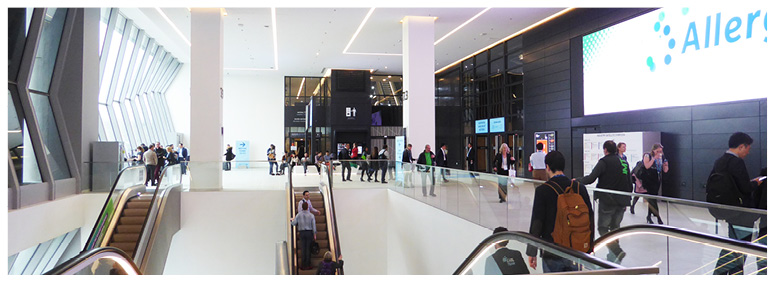Bigger and better than ever before, this year’s dynamic EASL ILC was held in Paris, France from the 11th–15th April 2018. This historic city, long recognised as a hub of culture and sophistication, provided a beautiful backdrop for the event as delegates arrived to pursue scientific excellence. Thousands of hepatology scientists, clinicians, and associates flocked to the Paris Expo Porte de Versailles, where >1,500 original presentations would be on offer; however, this was just the tip of the iceberg.
During the opening ceremony, performed before a crowd of delegates from across the globe, Prof Tom Hemming Karlsen, Secretary General of EASL, introduced the ILC as: “truly now an international platform for liver disease.” He went on to explain some of the innovations that the EASL had put in place for the meeting, including the inspiration for the congress format, which this year was modelled on the ‘everyday work’ of its attendees: “…when we do our job as hepatologists we interact with other specialists, we interact with each other, we discuss the patients during the morning rounds… and you will have morning rounds here that you can attend and you can participate in the discussions as if you were in your own centre.”
Thousands of abstracts were submitted from all over the world, showcasing a plethora of the greatest hepatological achievements. Each day, a huge variety of presentations took place, from plenary sessions to basic science sessions and late-breaking research conferences. The congress not only offered delegates wonderful opportunities to network with peers, but also to meet key opinion leaders in the field during the corresponding Expert Sessions and to enhance their skillsets in the learning centre. Interactivity was paramount at the ILC, where a hands-on, discursive approach was taken to maximise the learning opportunities for all attendees.
The meeting also included, for the first time, a collaboration between the EASL and the European Society for Medical Oncology (ESMO) in the form of a co-organised symposium to discuss the future of liver cancer. This impressive session highlighted a theme deeply interwoven within the congress itself: a multidisciplinary approach is integral to hepatological research and clinical practice. With discussion ranging from the latest therapies to personalised treatment, this co-operation between two of Europe’s titanic societies surely ensured that the future of liver cancer research will be standing on the shoulders of not one, but two giants.
Throughout the meeting, social media was ablaze as attendees shared photos from presentations, discussions on the late-breaking research, and, naturally, many stunning photos of the Eiffel Tower. As a platform for rapid communication, social media is second to none, and at the ILC it was used to its full potential to instantaneously disseminate crucial information to scientists around the world.
In the following Congress Review section, we bring you highlights from across this captivating meeting, including the latest research on topics such as cirrhosis, viral hepatitis, primary biliary cholangitis, and nonalcoholic steatohepatitis. For those of you lucky enough to have attended the ILC this year, we hope this section reignites your memory of the incredible event; for those of you who sadly missed out, we hope this brief overview can convey even a fraction of the passionate spirit at the very heart of this event.
Next year’s ILC will be held in beautiful Vienna, Austria, home of the Wienerschnitzel, the Habsburgs, and the harmonies of Wolfgang Amadeus Mozart. We look forward to seeing you there.

Presentation of New Liver Dialysis Technology
NEW and developing technologies were presented at the ILC, with the BioTech Village home to a myriad of product showcases. One such technology that premiered was DIALIVE. As part of their product launch, the ALIVER consortium published a short, animated video, as reported in a EASL ILC press release dated 11th April 2018.
This video communication was intended to increase public awareness of liver failure and the challenges associated with its management. Indeed, around 170,000 people die annually across Europe as a result of liver cirrhosis, with >1 million deaths attributed to the condition globally each year. There are also high numbers of individuals living with liver disease: 650 million globally, with 29 million of these being citizens of the European Union (EU).
The video began by presenting a number of the factors that put people at risk of liver disease, including long-term, excessive alcohol consumption and malnutrition. Having briefly summarised the risk factors, the video then stated that liver transplant was currently deemed the only plausible treatment for patients with liver failure; however, transplant rates were limited by the number of viable organs available.It is this treatment gap that DIALIVE, a liver dialysis device, aims to fill. The technology was developed by researchers at University College London, London, UK, and is currently undergoing clinical trials. As the video explained, the intention behind the technology is to extend the lives of patients with cirrhosis for a long enough period of time that either a transplant becomes available or their liver starts recovering. The results from the first clinical trials are now eagerly anticipated in order to see if DIALIVE will represent a step on the path to a new outlook for patients with liver failure.
Immunotherapy Beneficial in the Management of Hepatocellular Carcinoma
T CELLS engineered to present hepatitis B virus (HBV)-specific T cell receptors (TCR) have been shown to be an effective immunotherapy, preventing further lung metastases after liver transplant in hepatocellular carcinoma (HCC) patients, according to study results reported in a EASL ILC press release dated 12th April 2018. After 6 months of treatment with this novel immunotherapy, computed tomography (CT) imaging showed a volumetric reduction of nearly all lung lesions detected in HCC liver transplant patients, with no new lesions detected in the lung or liver up to the time of the congress. All tumour lesions in the lungs remained stable until January 2018.
HCC is the second most common cause of cancer mortality worldwide, with a poor prognosis and limited therapeutic options.1 Liver transplantation is an option for some HCC patients; however, HCC reoccurs in up to 20% of cases, with metastases to the lungs being the most common.1–3
Lead author, Dr Anthony Tan, Emerging Infectious Disease Programme, Duke-NUS Medical School, Singapore, explained: “We first had to test if short, integrated HBV DNA fragments in the tumour cells can produce HBV epitopes recognised by cytotoxic T cells.” The characterisation of the short, integrated HBV DNA fragments allowed researchers to identify HBV epitopes that were presented on the cell surface. Further analysis identified a region of the HBV envelope encoded by integrated HBV DNA fragments derived from the primary HCC of liver transplant patients with hepatitis B surface antigen (HBsAg)-negative HCC metastasis in the lungs. TCR specific for the HBV envelope were incorporated into T cells and, over a 6-month period, multiple adoptive transfers of the HBV-specific TCR into patients were performed, presenting with these encouraging CT results.
With >50% of all HCC cases thought to be associated with chronic HBV and up to 20% of HCC cases reoccurring in liver transplant patients, the potential impact of this novel treatment method could be vast.1,4 Dr Tan concluded: “Further development of this new immunotherapeutic strategy may offer new hope of a cure for HCC.”
References
- European Association for the Study of the Liver. EASL clinical practice guidelines: Liver transplantation. J Hepatol. 2016;64(2):433-85.
- Xiang ZW et al. Progress in the treatment of pulmonary metastases after liver transplantation for hepatocellular carcinoma. World J Helpatol. 2015;7(20):2309-14.
- Becker AK et al. Extrahepatic metastases of hepatocellular carcinoma: A spectrum of imaging findings. Can Assoc Radiol J. 2014;65(1):60-6.
- Ghouri YA et al. Review of hepatocellular carcinoma: Epidemiology, etiology, and carcinogenesis. J Carcinog. 2017;16:1.

Web-Based Lifestyle Intervention Programme Improves Liver Health
WEB-BASED lifestyle change intervention has been shown to be as effective as group-based, face-to-face programmes for improving weight loss and overall liver health in nonalcoholic fatty liver disease (NAFLD) patients. These results, highlighted and reported in a EASL ILC press release dated 13th April 2018, may present a more feasible and achievable management option for many NAFLD patients.
With structured lifestyle intervention programmes now recommended in NAFLD management guidelines, the team, led by Prof Giulio Marchesini, University of Bologna, Bologna, Italy, set out to develop a successful web-based lifestyle modification programme aimed at younger, busier patients who may not be able to attend traditional group intervention programmes. “Weight loss has long been recognised as an effective therapy for NAFLD, but the challenge has been creating the infrastructure to achieve it,” elucidated Prof Philip Newsome, Queen Elizabeth Hospital and University of Birmingham, Birmingham, UK, and EASL Governing Board Member. The Italian study included 716 NAFLD patients divided into two intervention groups: a 5-week, intensive, group-based programme (n=438) or a web-based series of five modules (n=278). NAFLD severity markers were evaluated at 6, 12, and 24 months follow-up and the percentage of patients who achieved a 10% weight loss was used as the study’s primary outcome.
According to Prof Marchesini, the primary outcome was achieved by >1 in every 10 patients in both intervention groups, and this coincided with a decrease in the surrogate markers of fibrosis. “This weight loss threshold has been associated with resolution of nonalcoholic steatohepatitis and regression of fibrosis in studies that have evaluated NAFLD histology,” explained Prof Marchesini. The team reported significant decreases in liver enzyme levels in both intervention groups; however, patients using the web-based programme were more likely to have a normal alanine aminotransferase level at both 6 months and 12 months (odds ratio: 2.34 and 2.22, respectively).
“Our study has shown that a web-based lifestyle modification programme is a feasible and practical way of achieving a clinically meaningful level of weight loss in our NAFLD patients,” concluded Prof Marchesini. For the estimated 25% of adults across the globe who have NAFLD, lifestyle modifications aimed at weight loss, improved dietary habits, and increased physical activity are essential, and the team hope to initiate similar web-based intervention programmes at other liver units.
Obeticholic Acid Treatment Demonstrates Antifibrotic Effects for Primary Biliary Cholangitis Patients
PRIMARY biliary cholangitis (PBC) is a rare autoimmune disease with numerous detrimental effects on the liver that ultimately lead to the development of fibrosis, cirrhosis, and hepatocellular carcinoma. Typically, the disease is treated with ursodeoxycholic acid (UDCA), but up to 40% of patients treated with UDCA have an insufficient response. Now, researchers have demonstrated that long-term treatment with obeticholic acid (OCA) can lead to the reversal or stabilisation of fibrosis in PBC patients who had an incomplete response to UDCA.
The POISE study, the results of which were reported in a EASL ILC press release dated 13th April 2018, was a biopsy substudy that examined patients who had undergone liver biopsies before and after 3 years of treatment with OCA. These biopsies were assessed via a six-tier staging system, ranging from no fibrosis to cirrhosis. Thirteen patients receiving UDCA at baseline ultimately had paired biopsies suitable for analysis; nine (69%) of these patients had pre-cirrhotic fibrosis and four (31%) had cirrhosis.
After 3 years of treatment, the results of these biopsies showed that most patients had an improved (n=6; 46%) or sustained (n=5; 38%) histological stage. Two patients (15%) had deteriorated. In addition, three of the four patients with baseline cirrhosis had improved to fibrosis while receiving this treatment.
“Eighty-five percent of the patients with PBC in this study with an incomplete response to UDCA had regression or no worsening of their fibrosis or cirrhosis after 3 years of OCA treatment, a period of time during which we would have expected some degree of fibrosis progression,” explained Dr Christopher Bowlus, University of California, Davis, California, USA.
These results represent a positive step in the management of this rare and complicated condition, providing a new and promising option for treatment. “Relevant changes are on the way for the management of patients with PBC, for which UDCA has been the only treatment option for a long time,” concluded Prof Marco Marzioni, University Hospital of Ancona, Ancona, Italy. Further research on the use of OCA is already underway.

New Therapeutic Option for Primary Sclerosing Cholangitis
A POTENTIAL therapeutic option for prolonging transplant-free survival in primary sclerosing cholangitis (PSC) patients has shown promise, according to the results of a Phase II multicentre study that was reported in a EASL ILC press release dated 13th April 2018. The development of new treatments for PSC is of importance because, although liver transplantation is an effective option for the treatment of advanced stages of the condition, there are presently no treatments that facilitate increased transplant-free survival.
The researchers investigated NGM282 therapy for PSC patients. NGM282, a nontumourigenic engineered analogue of fibroblast growth factor 19, has previously been shown to have potential as a viable treatment for nonalcoholic steatohepatitis. In this new study, 62 patients with PSC and an elevated alkaline phosphatase level were randomised to one of three study arms: placebo, daily 1 mg subcutaneous injection of NGM282, or daily 3 mg subcutaneous injection of NGM282.
While there were no significant reductions in serum alkaline phosphatase levels at 12 weeks in either active treatment study arm when compared with placebo, which was the study’s primary endpoint, there were significant reductions in several other variables. Patients in the 3 mg NGM282 study arm presented with significant reductions in alanine aminotransferase and aspartate aminotransferase serum levels at Week 12 (p<0.01 versus placebo). Furthermore, patients in both NGM282 study arms displayed reduced serum levels of 7α-hydroxy-4-cholesten-3-one when compared to the placebo study arm.
The researchers also reported that there were no differences between study arms in PSC-related clinical events. Adverse events in the NGM282 study arms were predominantly mild and able to be resolved while the patients were on treatment; the most commonly reported events were frequent stools, injection site reactions, and diarrhoea.
Summing up the key impact of the research, Prof Gideon Hirschfield, Institute of Immunology and Immunotherapy, University of Birmingham, Birmingham, UK, who was presenting the results, explained: “This study provides good evidence of relevant clinical activity for NGM282 in individuals with PSC and highlights the need to explore NGM282’s impact on liver fibrosis in larger studies of a longer duration.”
Rapid Automated Analysis of Nonalcoholic Steatohepatitis Histological Features
Automated analysis of nonalcoholic steatohepatitis (NASH) has been shown to be highly accurate at predicting histological patterns relating to hepatocellular ballooning and lobular inflammation in liver biopsy samples, according to data presented in a EASL ILC press release dated 13th April 2018. The deep-learning system created to detect and analyse these features was able to predict cell histological patterns with accuracies of 98% and 91% for ballooning and inflammation, respectively.
An expert histopathologist determined the ballooning and inflammation scores for liver biopsy samples from animal models of rats or mice fed on a choline-deficient, L-amino acid-defined diet supplemented with cholesterol. The deep-learning models were then constructed to detect and analyse these histological features. The initial training set of 31 animal models was used to train the device, which was then used to predict the histological features in four independent cohorts (n=271).
The resultant data showed excellent agreement between the histopathologist and the fully automated scores for ballooning and inflammation for each cohort at a cellular level (kappa coefficient: 0.84 and 0.81, respectively), with the full tissue samples (kappa coefficient: 0.71), and between whole slide imaging-based automatic scoring of inflammation on the training cohort (Rho=0.907).
Mr John Brozek from GENFIT, Lille, France, the company developing the deep-learning system, commented on the reasoning behind the study: “The histological evaluation of NASH by microscopy is time-consuming and limited by inter and intra-observer variability.” With liver biopsy remaining essential for establishing a NASH diagnosis and the severity of the disease, the aim of this novel diagnostic technique was to eliminate the subjectivity of interpreting histological images.
Commenting on the encouraging results, Mr Brozek explained: “Our automated scoring system for ballooning and inflammation showed a high correlation with expert evaluation and it is ready to be used for high-throughput activity scoring in preclinical studies or, in the near future, as a companion diagnostic tool for clinical application.” These results, coupled with the fact that the number of individuals with NASH is increasing rapidly worldwide, could revolutionise the diagnostic strategy for this disease.

The Beneficial Effect of a Mediterranean Diet
A MEDITERRANEAN diet, rich in fermented foods such as yoghurt and vegetables, has been linked to greater gut bacterial diversity and a lower risk of hospitalisation in patients with liver cirrhosis when compared with patients consuming a predominately Western diet, according to a EASL ILC press release dated 12th April 2018.
Alongside the primary drivers of liver cirrhosis (alcohol consumption and hepatitis B and C infections), gut microbiota has been linked to the pathogenesis and progression of cirrhosis: bacterial biodiversity has been shown to be significantly reduced in healthy individuals, compensated cirrhosis patients, and decompensated cirrhosis patients. Dr Jasmohan Bajaj, Virginia Commonwealth University, Richmond, Virginia, USA, explained that the aim of the study was to investigate the impact of diet on the progression of liver cirrhosis.
The research team recruited 157 liver cirrhosis patients from the USA, who predominately consumed a Western diet high in coffee and carbonated drinks, and 139 liver cirrhosis patients from Turkey exposed to a Mediterranean diet. Dietary and stool microbiota analysis revealed that the Turkish patients had a significantly greater level of gut bacteria diversity compared to patients from the USA. Analysis also showed that there was no difference between the biodiversity in healthy and cirrhosis individuals in Turkey, while in the USA there was a vast contrast in the biodiversity of the gut microbiome. Furthermore, there was a significantly higher number of liver-related hospitalisations in the USA population compared to the Turkish population.
Further work needs to be carried out to establish whether a change in diet can be used as a nonpharmacological alternative for protecting against liver disease, which, according to this investigation, could be likely. Prof Annalisa Berzigotti, University of Bern, Bern, Switzerland and EASL Governing Board Member concluded: “This is an important study stressing that an antioxidant-rich Mediterranean diet has a protective effect not only in the early phases of chronic liver disease but also in its more advanced phases.”
Promising Results for Hepatitis C Elimination from Iceland and Georgia
ENCOURAGING results have been reported in a EASL ILC press release dated 13th April 2018 from Iceland and Georgia regarding the efforts of both nations to eliminate the hepatitis C virus (HCV) at a population level. Despite the adoption of different approaches, both the Icelandic and Georgian initiatives have recorded high levels of engagement in the programmes, initiation of the use of direct-acting antiviral agents (DAA), and, ultimately, cure of chronically infected HCV patients; this suggests both countries are on track to achieve their HCV elimination goals.
Georgia was home to the world’s first HCV elimination programme, which operated in collaboration with the US Centers for Disease Control and Prevention (CDC). Initiated in April 2015, the programme’s positive results are now being revealed for the first time. Of 43,989 people diagnosed with HCV, 33,673 patients had begun DAA treatment and 24,273 individuals had already achieved a sustained virological response. “In the first 2 years of this programme, we have diagnosed more than one-quarter of our HCV-infected adults in Georgia, we have treated 77% of those diagnosed, and cured over 95% of those completing treatment,” explained Prof Tengiz Tsertsvadze, Infectious Diseases, AIDS and Clinical Immunology Research Center, Tbilisi, Georgia.
January 2016 marked the start of the Icelandic programme, which focussed on those who inject drugs, prisoners, and those who had advanced liver disease, as well as those who quickly become reinfected. “Encouragingly, even in individuals with recent intravenous drug use, DAA treatment, although challenging, resulted in an 87% cure rate, including in those that did not complete the treatment regimen,” explained Dr Valgerdur Rúnarsdóttir, Vogur Hospital, Reykjavík, Iceland. He added: “We would like to emphasise and encourage collaboration between addiction treatment centres in both screening and treating HCV. This is key to success in reaching the population in focus.”
These two programmes represent a positive step towards HCV elimination. The Icelandic results were particularly exciting, given its nature as an island and the programme’s defined target population. “If elimination of HCV is possible without a vaccine, it will surely be possible in Iceland,” explained EASL Governing Board Member Prof Markus Cornberg, Hannover Medical School, Hannover, Germany.
Treatment of Rare Liver Diseases
PROMISING PROGRESS in the development of therapies for three rare liver diseases was reported in a EASL ILC press release dated 14th April 2018. The developmental therapies, namely sebelipase alfa, givosiran, and ARO-AAT, were designed to treat lysosomal acid lipase (LAL) deficiency, acute intermittent porphyria (AIP), and alpha-1-antitrypsin (AAT) deficiency, respectively. The importance of this work was highlighted by Prof Marco Marzioni, EASL Governing Board Member, who declared: “Rare diseases are a greater challenge than you might expect, as apart from the difficulties in reaching a full diagnosis, there are often no effective treatments available.”
The first study examined the long-term use of sebelipase alfa, which was approved in 2015 for the treatment of LAL deficiency. The study followed 31 patients with LAL deficiency treated with a 1 mg/kg intravenous sebelipase alfa infusion every other week. The patients were followed for up to 96 weeks and the results demonstrated reductions from baseline across several measured variables: -44.4% in alanine aminotransferase, -38.4% aspartate aminotransferase, -17.6% liver volume, -14.9% liver fat content, and -16.5% spleen volume. Furthermore, most adverse events were mild-to-moderate in severity.
Also reported were the results of a three-part Phase I study assessing the efficacy, safety, tolerability, pharmacokinetics, and pharmacodynamics of givosiran in patients with AIP. One of the studies found that patients who were treated with 2.5 mg/kg givosiran on a monthly basis had a mean decrease of 83% in the annualised attack rate and, additionally, an 88% decrease in the number of haemin doses. During the course of the study, there were no serious adverse events reported.
Finally, the results of ARO-AAT pharmacological activity in non-human primates were announced. It was shown that, after two doses of 3 mg/kg ARO-AAT administered 4 weeks apart, non-human primates presented with a 89–91% mean decrease in serum AAT. This decrease was sustained for >7 weeks following the second of the doses, which the researchers argued lent support to the case for less frequent dosing with ARO-AAT.

Glecaprevir/Pibrentasvir First Real-World Study: Effective Treatment of Hepatitis C Virus Infections
ENCOURAGING results from the first real-world studies assessing the efficacy and safety of the combination drug glecaprevir/pibrentasvir (G/P) for the treatment of hepatitis C virus (HCV) infections were presented at this year’s ILC meeting and reported in a EASL ILC press release dated 12th April 2018. Sustained virological response (SVR), defined as undetectable HCV RNA 4 and 12 weeks after treatment, was measured in both Italian and German studies of HCV patients treated for 8–16 weeks.
The G/P combination is a relatively new direct-acting antiviral treatment, with the drugs inhibiting NS3/4A protease and NS5A, respectively. Until now, no real-word studies with G/P have been reported, despite initial Phase II and III trials reporting high SVR12 rates and a favourable safety profile.
The Italian study presented an interim analysis of 723 consecutively G/P-treated patients. Analysis of the data revealed that HCV RNA was undetectable in 74% of patients at Week 4 and in 98% at the end of treatment. Treatment-related adverse effects were few and were of mainly mild severity. Only three patients discontinued treatment prematurely.
Dr Roberta D’Ambrosio, University of Milan, Milan, Italy, commented: “Our real-world study involving more than 700 patients with chronic HCV infection confirmed that the effectiveness and safety profile of G/P were excellent across a range of different patient types.”
The ongoing German study assessed 638 The ongoing German study assessed 638 patients treated with G/P for 8 weeks. Adult patients with HCV genotypes 1–6, with or without compensated cirrhosis, who were treatment-naïve or treatment-experienced were included. Of the 49 patients with data at the time of presentation, 100% had achieved SVR12; this excluded those who had discontinued treatment prematurely (n=4), two of whom due to adverse effects.
Commenting on the real-world benefits of G/P combination treatment, Prof Thomas Berg, University of Leipzig, Leipzig, Germany, said: “We have found G/P to be a very useful addition to our HCV treatment armamentarium as it simplifies treatment decisions for the majority of patients; G/P has the potential to expand the treated population and support the goal of HCV elimination.”
Novel Primary Biliary Cholangitis Treatments Show Promising Results
PHASE II studies presented at EASL ILC 2018 and reported in a EASL ILC press release dated 13th April 2018, show encouraging preliminary efficacy, safety, and tolerability of tropifexor and seladelpar for the treatment of primary biliary cholangitis (PBC). These results may pave the way for effective treatment of the 3–5% of PBC patients who cannot tolerate ursodeoxycholic acid (UDCA), the current standard of care.
In the first study, PBC patients with a poor response to UDCA were randomly allocated to receive once daily placebo or tropifexor, a selective non-bile acid farnesoid X receptor agonist, at doses 30 µg, 60 µg, or 90 µg for 4 weeks. Decreases in markers of cholestasis and hepatocellular damage were observed in a dose-dependent manner, including a 72% reduction in gamma-glutamyltransferase and a 41% decrease in alanine aminotransferase at Day 28 in the 90 µg/day tropifexor group versus placebo (p<0.001). The team concluded that these results show the potential benefit of farnesoid X receptor agonism for the treatment of PBC, and the lack of reports of increased itch with tropifexor is a major advantage of this drug.
The second study involved patients who expressed an inadequate UDCA response; the patients were randomised to receive 2 mg, 5 mg, or 10 mg per day of the peroxisome proliferator-activated receptor-delta agonist seladelpar. The study’s primary efficacy outcome was a change from baseline in alkaline phosphatase (ALP) levels; at Week 26, 69%, 67%, and 79% of patients in the 5 mg/day, 5–10 mg/day, and 10 mg/day groups, respectively, had an ALP <1.67-fold higher than upper limit of normal. Overall, normal ALP levels at 26 weeks were reported in 29% of patients. The team concluded that seladelpar demonstrated an impressive level of activity over the study period: “In the absence of a transaminase safety signal, the doses of 5 mg/day and 10 mg/day appear to represent an appropriate risk/benefit profile,” stated Prof Gideon Hirschfield, University of Birmingham, Birmingham, UK. Like tropifexor, seladelpar also demonstrated no associated increase in pruritis, and some patients even experienced a decrease in itch, suggesting anti-pruritis activity.
These Phase II studies show promise for longer-term studies in PBC patients and may suggest alternative treatments for the progressive disease that do not involve UDCA. Commenting on these encouraging results, Prof Marco Marzioni, University Hospital Ancona, Ancona, Italy and EASL Governing Board Member, added: “Clinical research in PBC is very active at present and these two studies indicate how much scientists are engaging in designing studies aimed at providing patients with effective treatments.”
Phylogenetic Analysis Identifies the Origins of Hepatitis A Outbreak
Phylogenetic analysis of the viral agents behind a recent hepatitis A outbreak in Italy has linked the culprit pathogens to disease outbreaks in other European nations, as reported in a EASL ILC press release dated 12th April 2018.
The genetic sequencing of a virus, such as hepatitis A, can aid in the identification of the source of the disease and can highlight the population groups that are most at risk. Dr Massimo Iavarone, Fondazione IRCCS Ca’ Granda Maggiore Hospital, Milan, Italy, led a study that prospectively analysed 244 acute hepatitis A cases from the Lombardy region of northern Italy between January and May 2017.
The rarely fatal hepatitis A infection was shown to predominately affect men who have sex with men, leading to the number of infected persons increasing from 0.750 and 1.069 per 100,000 inhabitants in 2015 and 2016, respectively, to 9.512 per 100,000 inhabitants during the study period. Of these patients, 80% were hospitalised, with a median stay time of 7 days, and, while no patients required liver transplant, 14% of the patients were diagnosed with severe liver disease.
Molecular analysis of the patients revealed that 93% were infected with the hepatitis A 1A virus genetic variant, with the remaining 7% were diagnosed with hepatitis A 1B. The 1A hepatitis variant was identified to be the cause of hepatitis A outbreaks in the UK, Germany, and the Netherlands. Phylogenetic comparisons between the outbreaks showed that, of the 1A cases in Italy, 54% shared genetic origin with the UK viral variant, 45% with the Dutch variant, and 1% with the German 1A variant. Further analysis showed that the Netherlands strain accounted for 100% of the January hepatitis A cases in the Lombardy region, while the UK strain caused 68% of the cases in May. Dr Iavarone concluded: “Efforts to increase hepatitis A vaccine coverage in high-risk groups must be taken to strengthen population protection from HAV [hepatitis A viruses].”

New Information on Hepatitis E Virus Infection
INFORMATION that challenges the contemporary understanding of hepatitis E virus (HEV) infection was shared at the EASL ILC 2018 and reported in a EASL ILC press release dated 12th April 2018. The studies showed that blood-borne HEV transmission was more common than previously thought and that HEV infections can be fatal in both immunocompromised and immunocompetent individuals. With the reported incidence of HEV infection on the rise across Europe and >21,000 cases reported from 2005–2015, this information is of high importance and could ultimately lead to a change in the management paradigm of HEV infection.
The first study presented was a retrospective analysis of 150 HEV RNA-positive individuals; 69 of the patients were immunocompetent. Five years after HEV infection diagnosis, the mortality rate of immunosuppressed patients was 10%, and 3 out of 8 of these deaths were believed to be related to the HEV infection. Approximately half (53%) of the immunocompetent individuals were hospitalised for a combined total of 74 days; furthermore, 2 of these individuals who had pre-existing liver disease died as a result of developing acute-on-chronic liver failure. The researchers noted that their findings showed HEV infection could be associated with significant morbidity and mortality in both immunocompromised and immunocompetent individuals.
The second study examined the transmission of HEV infection. A retrospective analysis was conducted on the data of 37 patients with HEV infection who were immunosuppressed. Of the 30% of patients who later developed chronic HEV infection, 36% had originally been infected as a result of a HEV-positive blood donation. Of the 4 patients infected due to blood donation, 2 had been recipients of a heart transplant and had been treated for humoral rejection with a combination of rituximab and plasmapheresis. Based on their results, the study authors recommended that blood products for transplant or immunosuppressed patients should be screened for HEV RNA.
Prof Markus Cornberg, EASL Governing Body Member, spoke on the significance of the results, commenting: “Both studies emphasise the severity of HEV infection in vulnerable patients.” He went on to note: “These studies will lead to further discussions around if and how HEV screening of blood products should be carried out.”
Direct-Acting Antiviral Agent Therapy Slowing Hepatitis C Progression in Scotland
NATIONAL records of hepatitis C virus (HCV) patients in Scotland have been used to examine the efficacy of direct-acting antiviral agent (DAA) therapy in preventing the progression of the disease to decompensated cirrhosis. The results of this analysis were reported in a EASL ILC press release dated 12th April 2018. DAA cure HCV, providing a sustained virologic response, and are effective in >90% of HCV patients.
Scotland has an estimated 34,500 people chronically infected with HCV and is considered a world leader in the battle against viral hepatitis, making it an excellent source of HCV data. “Scotland’s national surveillance of HCV treatment and disease means we are ideally placed to examine the early impact of DAA treatment on HCV-related disease progression at a population level,” explained Prof Sharon Hutchinson, Glasgow Caledonian University, Glasgow, UK.
Data from the Scottish HCV Clinical and Diagnosis databases, combined with figures from the national inpatient hospital database, were analysed to examine what therapies were used to treat HCV patients from April 2014–March 2017. Additionally, the number of patients admitted to hospital with decompensated cirrhosis for the first time between 2000 and 2016 was recorded. From a cohort of 4,800 people, 83% were treated with DAA and 94% achieved a sustained viral response. In comparison to the previous 3 years, this scale-up of therapy was linked to a 29% and 39% reduction in first-time presentation of decompensated cirrhosis in patients previously diagnosed with HCV and those with HCV at the time of admission, respectively.
“We have been able to show that scale-up of therapy has resulted in substantially fewer patients presenting with decompensated cirrhosis, but has highlighted the need to address comorbidities that pose a continued risk of liver disease progression in those clear of the virus,” commented Prof Hutchinson.
EASL Governing Board Member Prof Markus Cornberg, Hannover Medical School, Hannover, Germany, concluded: “Recently, the value of DAA therapies has been challenged by a Cochrane review. These data are therefore very important in documenting not only sustained virological response, but also the prevention of morbidity and mortality.”








